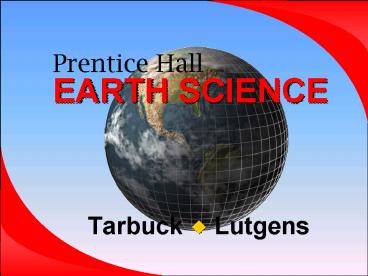Prentice Hall EARTH SCIENCE - PowerPoint PPT Presentation
1 / 30
Title:
Prentice Hall EARTH SCIENCE
Description:
The Precambrian encompasses immense geological time, from ... In North America, the mastodon and mammoth, both huge relatives of the elephant, became extinct. ... – PowerPoint PPT presentation
Number of Views:1009
Avg rating:3.0/5.0
Title: Prentice Hall EARTH SCIENCE
1
Prentice Hall EARTH SCIENCE
- Tarbuck Lutgens
?
2
Chapter 13
Earths History
3
13.1 Precambrian Time Vast and Puzzling
? The Precambrian encompasses immense geological
time, from Earths distant beginnings 4.56
billion years ago until the start of the Cambrian
period, over 4 billion years later.
? Precambrian Rocks
Shields are large, relatively flat expanses of
ancient metamorphic rock within the stable
continental interior.
Much of what we know about Precambrian rocks
comes from ores mined from shields.
4
Geologic Time Scale
5
Remnants of Precambrian Rocks
6
13.1 Precambrian Time Vast and Puzzling
? Earths Atmosphere Evolves
Earths original atmosphere was made up of
gases similar to those released in volcanic
eruptions todaywater vapor, carbon dioxide,
nitrogen, and several trace gases, but no oxygen.
Later, primary plants evolved that used
photosynthesis and released oxygen.
Oxygen began to accumulate in the atmosphere
about 2.5 billion years ago.
7
13.1 Precambrian Time Vast and Puzzling
? Precambrian Fossils
The most common Precambrian fossils are
stromatolites.
Stromatolites are distinctively layered mounds
or columns of calcium carbonate. They are not the
remains of actual organisms but are the material
deposited by algae.
Many of these ancient fossils are preserved in
cherta hard dense chemical sedimentary rock.
8
13.2 Paleozoic Era Life Explodes
? Following the long Precambrian, the most recent
540 million years of Earths history are divided
into three eras Paleozoic, Mesozoic, and
Cenozoic.
9
13.2 Paleozoic Era Life Explodes
? Early Paleozoic History
During the Cambrian, Ordovician, and Silurian
periods, the vast southern continent of Gondwana
encompassed five continents (South America,
Africa, Australia, Antarctica, and part of Asia).
10
Gondwana and the Continental Landmasses
11
13.2 Paleozoic Era Life Explodes
? Early Paleozoic Life
Life in early Paleozoic time was restricted to
the seas.
12
Life in the Ordovician Period
13
13.2 Paleozoic Era Life Explodes
? Late Paleozoic History
Laurasia is the continental mass that formed
the northern portion of Pangaea, consisting of
present-day North America and Eurasia.
By the end of the Paleozoic, all the
continents had fused into the supercontinent of
Pangaea.
14
Late Paleozoic Plate Movements
15
13.2 Paleozoic Era Life Explodes
? Late Paleozoic Life
Some 400 million years ago, plants that had
adapted to survive at the waters edge began to
move inland, becoming land plants.
The amphibians rapidly diversified because
they had minimal competition from other land
dwellers.
16
Armor-Plated Fish
17
Model of a Pennsylvanian Coal Swamp
18
13.2 Paleozoic Era Life Explodes
? The worlds climate became very seasonal,
probably causing the dramatic extinction of many
species.
? The late Paleozoic extinction was the greatest
of at least five mass extinctions to occur over
the past 500 million years.
19
13.3 Mesozoic Era Age of Reptiles
? Dinosaurs were land-dwelling reptiles that
thrived during the Mesozoic era.
? Mesozoic History
A major event of the Mesozoic era was the
breakup of Pangaea.
20
13.3 Mesozoic Era Age of Reptiles
? Mesozoic Life
Gymnosperms are seed-bearing plants that do
not depend on free-standing water for
fertilization.
The gymnosperms quickly became the dominant
plants of the Mesozoic era.
21
Canadian Rockies Were Formed Throughout the
Cretaceous Period
22
13.3 Mesozoic Era Age of Reptiles
? The Shelled Egg
Unlike amphibians, reptiles have shell-covered
eggs that can be laid on the land.
The elimination of a water-dwelling stage
(like the tadpole stage in frogs) was an
important evolutionary step.
23
13.3 Mesozoic Era Age of Reptiles
? Reptiles Dominate
With the perfection of the shelled egg,
reptiles quickly became the dominant land animals.
At the end of the Mesozoic era, many reptile
groups became extinct.
24
The Flying Reptile Pteranodon
25
Fossil Skull of an Extinct Crocodile
26
13.4 Cenozoic Era Age of Mammals
? The Cenozoic era is divided into two periods of
very unequal duration, the Tertiary period and
the Quaternary period.
? Plate interactions during the Cenozoic era
caused many events of mountain building,
volcanism, and earthquakes in the West.
27
13.4 Cenozoic Era Age of Mammals
? Mammalsanimals that bear live young and
maintain a steady body temperature replaced
reptiles as the dominant land animals in the
Cenozoic era.
? Angiospermsflowering plants with covered
seedsreplaced gymnosperms as the dominant land
plants.
28
13.4 Cenozoic Era Age of Mammals
? Mammals Replace Reptiles
Adaptations like being warm blooded,
developing insulating body hair, and having more
efficient heart and lungs allow mammals to lead
more active lives than reptiles.
29
Fossils from La Brea Tar Pits
30
13.4 Cenozoic Era Age of Mammals
? Large Mammals and Extinction
In North America, the mastodon and mammoth,
both huge relatives of the elephant, became
extinct. In addition, saber-toothed cats, giant
beavers, large ground sloths, horses, camels,
giant bison, and others died out on the North
American continent.
The reason for this recent wave of extinctions
puzzles scientists.































